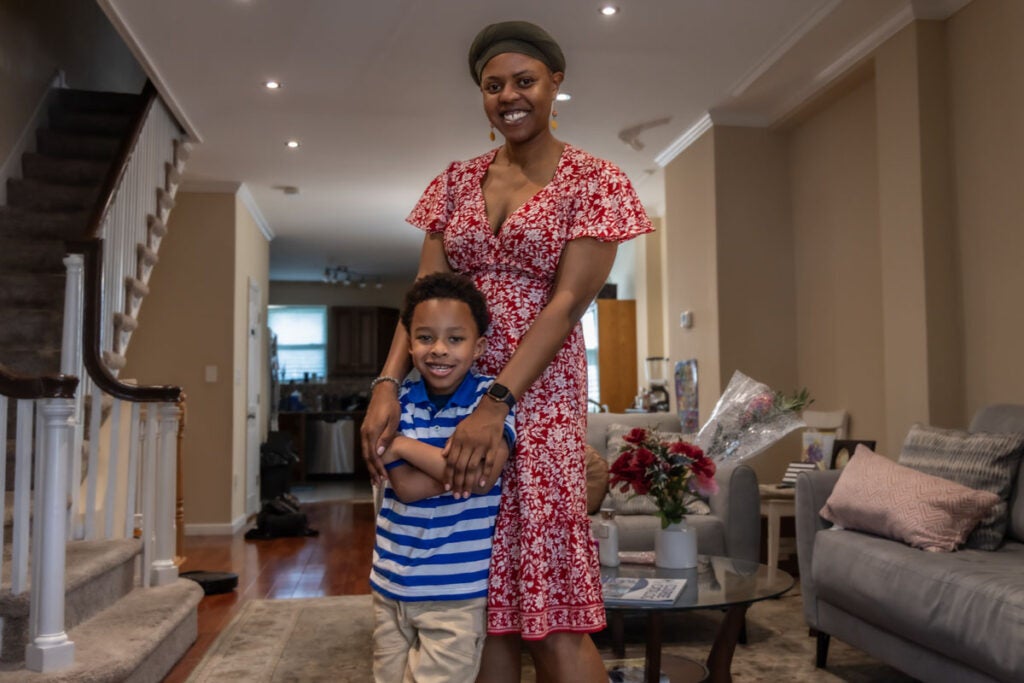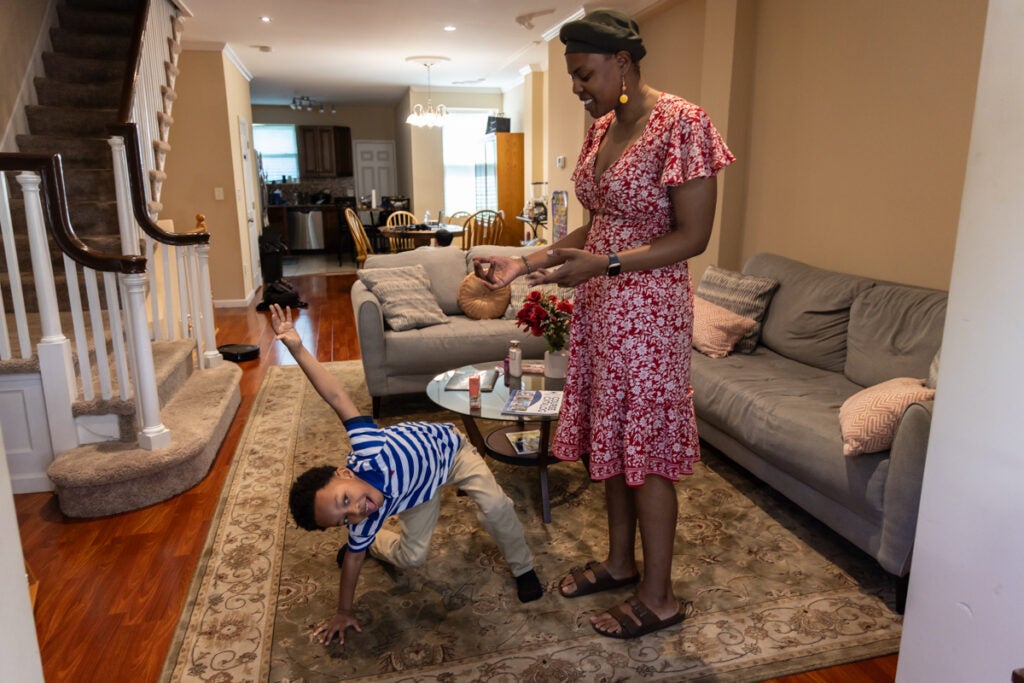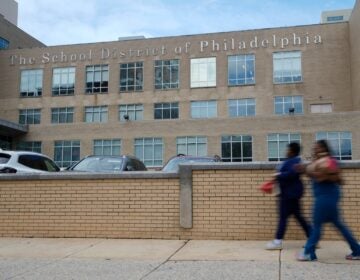‘Kids who get lost in that shuffle’ — How Philly’s underfunded schools struggle to support students with autism
Some parents say their children are not supported enough. The School District of Philadelphia says they need more staff and resources.
Listen 12:02
Constance Jones and her son, Austen, during a typical day of online learning with PA Cyber. (Kimberly Paynter/WHYY)
This story is from The Pulse, a weekly health and science podcast.
Find it on Apple Podcasts, Spotify, or wherever you get your podcasts.
When Constance Jones’ son Austen was 2 years old, she noticed he struggled with speaking, and lagged behind in language development. He was diagnosed with autism.
“It was scary,” she said. “I cried a lot because I was confused.
Jones did not know much about autism, but knew she had to prepare Austen for school. She looked for resources and guidance, but found it hard to decide where to send Austen to school even after talking to school district and daycare staff.
Their neighborhood public school did not have room for him in the autistic support class, so she took him to the next closest school, which was the one she went to when she was growing up.
She talked to the staff ahead of kindergarten to make sure they knew he is on the autism spectrum and needs special services. They mapped out a plan for his education, called an individualized education program or IEP.

But despite the planning, Austen struggled in class. Sometimes he would be shy. Other times, he would get frustrated or get in trouble. She says the school told her they were taking away Austen’s recess or lunch because of something he did. But she said the problem is that he did not understand why he was in trouble, especially if he was just doing what other kids were doing.
“It was: if this child does something and we see you’re doing it now, you’re getting in trouble too. And that was not computing to him,” she said.
Anytime there was an issue at school, Jones said, she would show up there.
“So I talked to the principal and he would evade me.”
After a few months, she felt like it was not working out, and would often wonder: “Are you guys just babysitting my child, or are you actually trying to help them educationally? And it feels like for a lot of these schools, they’re just babysitting.”
She started homeschooling Austen to give him the one-on-one attention he needs to learn. Now, Austen, 6, takes classes online with a cyber charter school, and if he is having a bad day, she can adjust.
“I’m not as concerned about him having to be around 25 kids or 15 kids if the teacher can’t control the classroom, I’m more concerned (with): Can my son read?”

Jones created support networks for herself, such as a Facebook group for parents in Philadelphia who have children on the autism spectrum, and believe the city needs to offer more options.
I spoke to three other parents in the group and they told me their concerns: kids with autism not getting enough attention at school, not learning, and being disciplined for behavior that is part of their neurodiversity.
David Mandell is familiar with these concerns. He directs Philly AIMS, a program at the University of Pennsylvania that specializes in improving education for students with autism. They have worked with the School District of Philadelphia for more than a decade.
The district says more than 5,000 of their students are on the autism spectrum, and Mandell estimates that more than 20,000 students in the district have IEPs, meaning they need special services . He said every year, the district has around three months to do an annual review for all those students.
“It’s very resource intensive,” Mandell said. “It requires parents responding in a timely way. It requires there being staff on the school district side. And there are kids who get lost in that shuffle because of just the sheer volume of work that has to happen.”
He also said sometimes staff struggle to provide the proper education for students on the autism spectrum, just because they may not have the skills or experience.
“Principals don’t go to school to learn evidence-based instruction and supports for kids on the autism spectrum. It probably was touched on once in one of their classes, and so we are thrilled when we go to a school and we find a principal who has any kind of special education background.”
Subscribe to The Pulse
PhillyAIMS works with teachers to help them use the best available evidence when it comes to teaching students on the autism spectrum.
Long time special education teacher Donna Dodd called their training “the best training I had received as an educator” because it was “focused and specialized for students with autism.”
She had been part of the partnership since the beginning in 2008. Dodd said before that, her school did not have autistic support classes and she had to do a lot of research on her own to teach students with autism, emotional disturbances, and learning disabilities.
Mandell said the partnership allows his team to study autism education, and the school district to put the latest research into practice. But he also said the school district is up against some big hurdles.
First, Philadelphia is underfunded by more than a billion dollars, according to a state commission report earlier this year, which is major obstacle to having more classrooms for students on the autism spectrum, said Nathalie Nérée, chief of special education and diverse learners at the school district.
“In a perfect world, where we get all those billion dollars, we would have programs at every school so that every student can attend the school of their choice, and first and foremost, the school of their neighborhood.”
Another issue is hiring and retaining special education teachers.
Second, Mandell said it is difficult to tell how a student on the autism spectrum is progressing. He said that teachers in a general education classroom can use grades to tell how a student is doing.
“With autism, we are lousy at figuring out, based on the skill set or the abilities that this child is showing now, where they’re going to be in a year.”
Last of all, Mandell said that schools, despite their best efforts, are simply not designed for students who have learning differences and need individualized education programs.
“Families often feel like if their child got more resources and a specific form of instruction, their child would do a lot better. And so that creates … a tension often between parents and school administrators. And administrators and teachers vary in their ability to work with parents on those issues.”
“A lot of times we see teachers who are amazing teachers, but they didn’t go to school to learn how to work with adults; they don’t know how to talk with parents about the IEP or the work they’re doing in the classroom. And so there’s a communication challenge between the parent and the teacher or the parent and the principal even when instruction looks like we would hope.”
Mandell says, of course, parents want to see more resources put towards their child’s education and that goes beyond kids with autism or in special education.
“It’s why we have all these advocacy groups and there’s constant lawsuits about what instruction in general should look like and what resources in these schools should look like,” Mandell said.
Mandell acknowledges that parents are struggling with making sure that their child’s IEP is met in schools. He says what we should do about it is “open to debate.”
WHYY is your source for fact-based, in-depth journalism and information. As a nonprofit organization, we rely on financial support from readers like you. Please give today.







